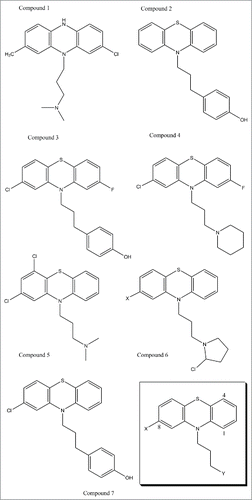Figures & data
FIGURE 1 (previous page). This figure presents novel drugs designed for in vivo and in vitro studies as possible treatment of Sporadic Fatal Insomnia. The design was achieved with the intent of allowing the methionine in position 129 on the mutated prion protein to be demethylated by proteasic activity. The design was therefore done to increase selectivity, and, effectiveness, by imposing some kind of rigidity on the tail and to refine its directionality. The first compounds were conceived to improve selectivity and toxicity. Some substitutions were executed to enhance affinity, whereas Compound 6 was particularly created to induce N-methylation of the Met129 located on the Fatal Insomnia Prion, however, increased toxicity may be expected, together with potency. Compound 3 and 2 were produced to infiltrate the prion further, perhaps by interacting with tyrosine residues, and to sterically compare with each other. Analogously, Compound 5 could offer further information on both pharmacokinetic and binding behaviours. Compound 4 was designed to underline molecular symmetry and to understand whether fluorine could be interchanged with the chlorine in an aim to decrease nephrotoxicity. Similar observations have been made for Compound 1. Further rigidity may also be affected with the introduction of a double bond in positions 3 and 4 of the tertiary amine. Finally, Compound 7 was docked with its substrate (FI-prion) as a comparative test with the chlorpromazine-substrate (FI-prion) complex and showed promising, although preliminary, results. In the bottom right corner, we can find illustrated the generic pharmacophore for these phenothiazine derivatives.

